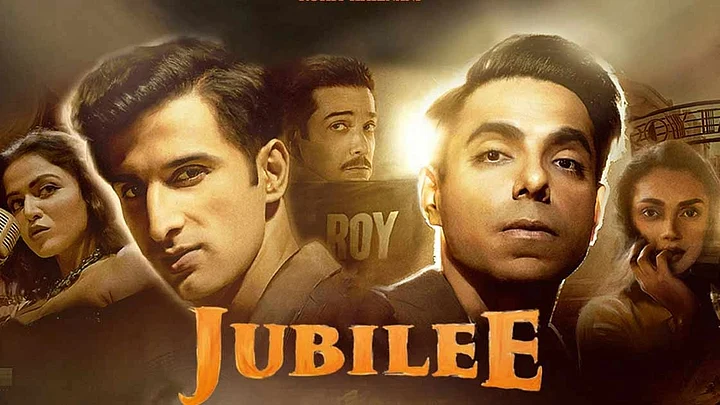One of the most talked-about shows of late is Vikramaditya Motwane's Jubilee, streaming on Amazon Prime Video. The 10-part series is a fictional account of the early days of the Hindi film industry - from a newly-independent India to the early 50s.
The follows the journey of Roy Talkies, one of the first movie studios, and its co-founders Shrikant Roy and Sumitra Kumari. It also documents the journeys of two rising stars - Binod Das and Jay Khanna.
Jubilee pays a great homage to real-life stars and directors from that period and explores the evolution of Indian cinema. Let's take a look at some of the influences the show might have drawn from:
Roy Talkies - Bombay Talkies
Though Roy Talkies isn't based on a particular real-life film studio, it loosely draws inspiration from the legendary Bombay Talkies. Founded in 1934 by husband-wife duo Himanshu Rai and Devika Rani, Bombay Talkies was one of the earliest and most successful film studios in India. The studio was responsible for launching stars like Ashok Kumar and Dilip Kumar, among others.
Bombay Talkies was built in Malad. Himanshu and Devika brought in state-of-the-art technology from Germany and hired technicians from Europe to oversee the infrastructure. Editing rooms, a preview theatre, sound and echo-proof stages were some of the facilities that the studio offered.
Jawani Ka Hawa, the first film that Bombay Talkies produced in 1935, was a hit. It featured Devika Rani and Najam-Ul-Hasan in lead roles. Another controversial but very popular movie to have been backed by the studio was Achuut Kanya (1936).
With the advent of World War II began Bombay Talkies' decline. When the British government prevented the German technicians from working at the studio in 1939, it was a huge blow. This was followed by Himanshu's untimely death in 1940. Finally, the studio shut down in the 1950s.
Shrikant Roy & Sumitra Kumari - Himanshu Rai & Devika Rani
The characters of Shrikant Roy and Sumitra Kumari are somewhat modelled on Himanshu Rai and Devika Rani, the co-founders of Bombay Talkies. They met each other while Himanshu was shooting for his movie A Throw Of Dice (1929), an Indo-German co-production directed by Franz Osten.
Himanshu and Devika starred together in Karma (1933), a film that reportedly holds the record for the longest on-screen kiss in Indian cinema. It was Himanshu's first talkie film, while Devika Rani was making her acting debut.
In 1934, the couple, along with a few others, set up Bombay Talkies as a joint stock company. The films made by the studio were a significant shift from the early silent movies being made by Himanshu, like The Light Of Asia or Prem Sanyas (1926), Shiraz (1928) or A Throw of Dice.
Bombay Talkies' first movie Jawani Ki Hawa was a romantic whodunit, while the second one, Jeevan Naiya, was also a romantic drama. Acchut Kanya (1936), which also starred Devika Rani and Ashok Kumar, turned the game by touching upon the subject of untouchability.
The films that Himanshu and Devika made after that also dealt with social issues - Janma Bhoomi (1936), Izzat (1937), Jeevan Prabhat (1937), Nirmala (1938) and Durga (1939) being a few examples.
The Birth of Ashok Kumar
Binod Das aka Madan Kumar's character (Aparshakti Khurana) takes us back to the torrid affair that resulted in a lab assistant becoming a screen icon, Ashok Kumar. The story began during the shooting of Jawani Ka Hawa, when Devika Rani fell for her co-star, Najam-Ul-Hasan. The pair was cast opposite each other once again in Jeevan Naiya (1936). This time, they eloped to Calcutta.
Himanshu Rai's co-worker and friend Sasadhar Mukherjee tracked the duo and somehow convinced Devika to return to her husband Himanshu. Najam-Ul-Hasan was unceremoniously fired and thus began the hunt for a new male lead. Rumours had it that this time Himanshu wanted to make sure the hero was nowhere extraordinary but rather average.
Sashadhar Mukherjee’s brother-in-law Kumudlal Kunjilal Ganguly was a lab assistant at Bombay Talkies, and his name suddenly came up. Despite resistance from other board members, Rai was convinced he had found his leading ‘average’ man and Ganguly’s name was rechristened as Ashok Kumar.
Jay Khanna - Raj Kapoor & Dev Anand
Jay Khanna's (Sidhant Gupta) character reminds us of Raj Kapoor. The iconic actor-director was also the son of a theatre personality and came to Bombay from Pakistan (though not during the Partition). Like Jay Khanna, Raj Kapoor was also helped by the Russians in achieving his stardom. In a few scenes, Jay embodies characteristics of the tramp character from Shree 420. Then again, there's a hint of Dev Anand too. When we are first introduced to him, Jay is seen dancing with a cigarette dangling from his lips and a hat he keeps shuffling in place.
(At The Quint, we question everything. Play an active role in shaping our journalism by becoming a member today.)
